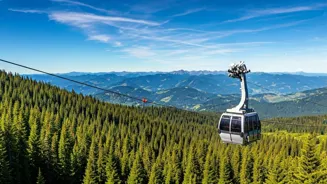Ambitious Ropeway Project
India is set to undertake a large-scale ropeway project, a move that underscores the nation's commitment to enhancing infrastructure and improving connectivity.
This initiative involves the establishment of approximately 50 different ropeway routes. These routes will span across 14 states, thereby facilitating access to a wide array of regions. The purpose of the project is to enhance transportation options, particularly in areas where conventional modes of transport are either challenging or not viable. The expansion is expected to boost tourism in several key locations, creating more accessible travel options. These ropeways will link several popular and key locations within the country, including the areas around Amarnath, Sonamarg, and Ooty. This project is poised to revolutionize transportation in these regions, thus promoting accessibility for residents and tourists.
States Covered Under
The initiative to install ropeways is expansive, involving numerous states across India. A total of 14 states are included in this project. These states are expected to witness significant improvements in transportation infrastructure. The implementation of the ropeways is expected to improve connectivity in several regions that currently have limited or difficult accessibility. The exact locations for the 50 planned routes are yet to be fully disclosed. However, it is confirmed that the project will impact diverse terrains and geographical landscapes. The focus of this project is not only on enhancing tourism but also on improving the overall movement of people and goods within the targeted regions.
Strategic Benefits Envisioned
The advantages of this project extend beyond simple transportation improvements. The development of ropeways is considered to provide several strategic advantages. One key benefit is the potential increase in tourism across several key destinations. Easier access to these areas will encourage more visitors, thus boosting the local economies. Ropeways are also expected to reduce travel times, particularly in areas with challenging terrain. The project could provide a reliable and efficient mode of transport for both residents and visitors. The government anticipates that ropeways would reduce traffic congestion, thereby decreasing pollution levels in the affected areas. Furthermore, the construction of these ropeways might encourage investment in remote regions, thereby accelerating economic growth.
Focus On Key Locations
The selection of sites for the new ropeway routes reflects a strategic approach, targeting some of India's significant destinations. The regions selected for ropeway development include Amarnath, known for its religious significance, and Sonamarg, famous for its scenic beauty. These areas are expected to experience a notable surge in tourism due to easier accessibility. Ooty, a popular hill station, is another destination that would benefit from the project. The introduction of ropeways in these locations would make it easier for people to explore and enjoy these destinations. The accessibility improvement would likely attract both domestic and international tourists. The focus on connecting key destinations is aimed at stimulating both tourism and economic growth in the regions.
Project Implementation Details
While the specifics of the project are still developing, certain features are becoming clear. The project will involve the construction of approximately 50 different ropeway routes. This large number demonstrates the extensive scale of the infrastructure plan. These routes will be spread across 14 states, highlighting the broad geographical impact. The project's progress will likely be monitored closely, with updates expected in the near future. Detailed plans for each of the 50 ropeway routes, including timelines and specific locations, are expected to be released in due course. Given the extensive scale of the undertaking, the project could necessitate collaboration between the central and state governments.

